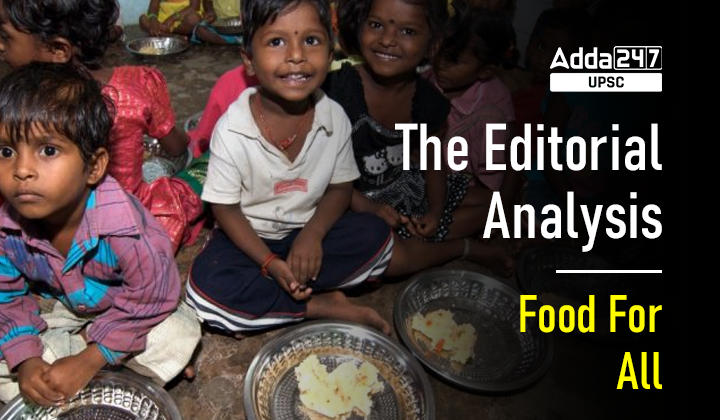Table of Contents
Food For All: Relevance for UPSC
GS 3: Food Security
Food For All: Why in news?
- This year’s World Food Day (October 16) has been a reminder to ensure that the most vulnerable people within our communities have easy access to safe and nutritious food.
- The promise to end hunger by 2030 is possible only through collective and transformational action to strengthen agri-food systems; better production, better nutrition, a better environment, and a better life.
Food For All: Context
- Globally, food and nutrition security continue to be undermined by the impacts of the COVID-19 pandemic, climate change, spiralling food inflation, conflict, and inequality.
- Today, around 828 million people worldwide do not have enough to eat, and over 50 million people are facing severe hunger.
Food For All: What Hunger Hotspots Outlook (2022-23) says about the food crisis?
- Hunger Hotspots Outlook (2022-23) a report by the Food and Agriculture Organization of the United Nations (FAO) and the World Food Programme (WFP) — forebodes escalating hunger, as over 205 million people across 45 countries will need emergency food assistance to survive.
Food For All: Importance of FAO and World Food Day
- Since 1948, the FAO has continued to play a catalytic role in India’s progress in the areas of crops, livestock, fisheries, food security, and management of natural resources through the promotion of sustainable practices.
- World Food Day is a reminder to ‘Leave No One Behind’, and is an opportunity — perhaps the most urgent one in recent history — for nations to strengthen food security nets, provide access to essential nutrition for millions and promote livelihood for vulnerable communities.
Food For All: Challenges before India to increase its Food production?
- India is now one of the largest agricultural product exporters.
- During 2021-22, it recorded $49.6 billion in total agriculture exports — a 20% increase from 2020-21.
- However, recent climate shocks have raised concerns about India’s wheat and rice production over the next year.
- By 2030, India’s population is expected to rise to 1.5 billion. Agri-food systems will need to provide for and sustainably support an increasing population.
Food For All: India’s greatest contributions to equity in food
- National Food Security Act (NFSA) 2013 which anchors the Targeted Public Distribution System (TPDS), the PM POSHAN scheme (earlier known as the Mid-Day Meals scheme), and the Integrated Child Development Services (ICDS).
- Today, India’s food safety nets collectively reach over a billion people.
- The WFP works with State and national governments to strengthen these systems to reach the people who need them most.
- The Government continues to take various measures to improve these programmes with digitisation and measures such as rice fortification, better health, and sanitation.
- Food safety nets and inclusion are linked with public procurement and buffer stock policy — visible during the global food crisis (2008-12) and the COVID-19 pandemic fallout, whereby vulnerable and marginalised families in India continued to be buffered by the TPDS which became a lifeline.
- An International Monetary Fund paper titled ‘Pandemic, Poverty, and Inequality: Evidence from India’ asserted that ‘extreme poverty was maintained below 1% in 2020 due to the Pradhan Mantri Garib Kalyan Anna Yojana (PMGKAY).
Food For All: How India led the global conversation on reviving millet production?
- India has led the global conversation on reviving millet production for better lives, nutrition, and the environment, including at the UN General Assembly, where it appealed to declare 2023 as the International Year of Millets.
- It is the world’s leading producer of millets, producing around 41% of total production in 2020.
- The national government is also implementing a Sub-Mission on Nutri-Cereals (Millets) as part of the National Food Security Mission.
- State-level missions in Odisha, Madhya Pradesh, and Andhra Pradesh are a testament to India’s resolve to revive these indigenous crops.
Importance of Millet
- Millet conservation and promotion contribute to addressing food security, improved nutrition, and sustainable agriculture, which aligns with the Sustainable Development Goals (SDG) agenda.
- Millet production has been proven to enhance biodiversity and increase yields for smallholder farmers, including rural women.
- The International Fund for Agricultural Development’s (IFAD’s) Tejaswini programme with Madhya Pradesh showed that growing millets meant a nearly 10 times increase in income (₹1,800 per month in 2013-14 to ₹16,277 in 2020-21), with better food security because millet crops were not impacted by excessive rainfall.
- A study by the FAO on millets in India emphasises strengthening value chains for enhancing nutritional benefits and increasing farmers’ incomes.
Food For All: What is the way forward?
- It is important to place a greater focus on climate adaptation and resilience building.
- There is increased recognition to move away from conventional input-intensive agriculture towards more inclusive, effective, and sustainable agri-food systems that would facilitate better production.
- There have also been a series of initiatives by the Government of India on better production and improving food access, especially for vulnerable populations.
- Soil degradation by the excessive use of chemicals, non-judicious water use, and declining nutritional value of food products need urgent attention.
- India’s upcoming G20 presidency is an opportunity to bring food and nutrition security to the very centre of a resilient and equitable future.
Food For All: Conclusion
It is clear that the path to a better life resides in transforming food systems, making them more resilient and sustainable with a focus on equity, including by incentivising the protection of the commons; enhancing food and nutrition security and social protection networks, including by providing non-distortionary income support; promoting production and consumption of nutritious native foods.



 TSPSC Group 1 Question Paper 2024, Downl...
TSPSC Group 1 Question Paper 2024, Downl...
 TSPSC Group 1 Answer key 2024 Out, Downl...
TSPSC Group 1 Answer key 2024 Out, Downl...
 UPSC Prelims 2024 Question Paper, Downlo...
UPSC Prelims 2024 Question Paper, Downlo...




